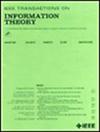Blind Interference Alignment for MapReduce: Exploiting Side-Information With Reconfigurable Antennas
IF 2.2
3区 计算机科学
Q3 COMPUTER SCIENCE, INFORMATION SYSTEMS
引用次数: 0
Abstract
In order to explore how blind interference alignment (BIA) schemes may take advantage of side-information in computation tasks, we study the degrees of freedom (DoF) of aMapReduce的盲干扰对准:利用可重构天线挖掘侧信息
为了探索盲干扰对齐(BIA)方案如何在计算任务中利用侧信息,我们研究了全双工无线MapReduce应用中出现的K用户无线网络设置的自由度(DoF)。在这种情况下,假设接收机具有可重构天线和信道知识,而发射机两者都不具备,即发射机缺乏信道知识,只配备常规天线。问题公式的核心成分是MapReduce的Shuffle阶段产生的消息结构,其中每个发送器都有一个需要传递给不同接收器的消息子集,每个接收器都有一个预先可用的消息子集作为副信息。我们通过将问题分解为不同的阶段来处理这个问题,这些阶段有助于确定整个解决方案的关键成分。第一阶段出现的新元素,称为群播消息广播,包括发射器上的外部最大距离可分离(MDS)代码结构,以及用于迭代确定接收器上群播最优可重构天线切换模式的算法,以实现消息内(同一消息的符号之间)校准。下一阶段,称为带侧信息的单播,揭示最佳的消息间(在不同消息的符号之间)对齐模式,以利用侧信息,并通过重新标记消息,连接到所需的MapReduce设置。
本文章由计算机程序翻译,如有差异,请以英文原文为准。
求助全文
约1分钟内获得全文
求助全文
来源期刊

IEEE Transactions on Information Theory
工程技术-工程:电子与电气
CiteScore
5.70
自引率
20.00%
发文量
514
审稿时长
12 months
期刊介绍:
The IEEE Transactions on Information Theory is a journal that publishes theoretical and experimental papers concerned with the transmission, processing, and utilization of information. The boundaries of acceptable subject matter are intentionally not sharply delimited. Rather, it is hoped that as the focus of research activity changes, a flexible policy will permit this Transactions to follow suit. Current appropriate topics are best reflected by recent Tables of Contents; they are summarized in the titles of editorial areas that appear on the inside front cover.
 求助内容:
求助内容: 应助结果提醒方式:
应助结果提醒方式:


